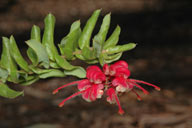Information about plants in flower this week
A news sheet prepared by a Gardens' volunteer, featuring the flowers, fruits and foliage of a selection of plants in the Australian National Botanic Gardens .
Numbers before each plant refer to temporary IFTW labels in the gardens.
Numbers in square brackets [ ] refer to garden bed Sections. Featured plants are in bold type.
View past issues of 'In Flower This Week'.
8 June - 21 June 2016
Today we will start our walk from the rear of the café then continue up the hill and along the road behind the Rock Garden.
- On your left as you walk past the rear of the café is Elaeodendron australe var. australe [Section 125], or Red Olive Berry, a small tree with reddish orange fruits and shiny green leaves. It grows along the east coast from Moruya in southern New South Wales to the central coast of Queensland.
- Continuing on your left is Cyathea australis [Section 125], or Rough Tree Fern. Old specimens can have trunks 10 metres high. It grows in wet forests and rainforests of all eastern Australian states.
- Also on your left is Asplenium australasicum [Section 125], or Birds Nest Fern. Their clumps of long light green leaves can reach 3 metres in diameter. The leaves have a prominent midrib and the spores on the back of the leaves are in parallel rows. It is found along the coast from central New South Wales to Cape York, Queensland.
- Further on your left is Correa lawrenceana var. glandulifera [Section 125], a large shrub with shiny green leaves and yellow-green bell flowers. It grows on the coast near the New South Wales/Queensland border.
- Still on your left is Acronychia littoralis [Section 125], a small tree with shiny leaves and strongly-scented greenish-cream flowers and bunches of green berries. The Scented Acronychia or Beach Acronychia is an endangered species that grows naturally in north-eastern coastal New South Wales and a few areas in adjacent Queensland.
- Continuing on your left is Sarcomelicope simplicifolia subsp. simplicifolia [Section 104], a small tropical tree with shiny green leaves and lots of purple berries. It grows from southern New South Wales to northern Queensland.
- Acmena smithii [Section 140], on the corner on your left, is a small tree with a dense crown of shiny green leaves covered in clusters of purple berries. The best-known member of the lilly pillies, it is widespread in east coast rainforests from north Queensland to Victoria. It is also found on King Island.
- Further on your left is Banksia aquilonia [Section 140], a tree to 8 metres tall with long green leaves and tan young cones bearing developing pale yellow flowers. It is native to north Queensland.
- Turn right along the road to see on your right Chamelaucium ‘Cascade Brook’ [Section 17], or Geraldton Wax. Endemic to Western Australia, it is an open airy bush with masses of long-lasting purplish-pink 5-petalled flowers with darker centres.
- Further on your right is Grevillea ‘Mason’s Hybrid’ [Section 15h], a spreading bush with large spider blooms of pink, red and orange. This hybrid arose as a seedling from seed collected from an upright glaucous form of Grevillea bipinnatifida. The other parent is presumed to be G. banksii.
- Continuing on your right is Grevillea ‘Peaches and Cream’ [15h], with attractive deeply-divided leaves and large flower heads of pink and cream. This hybrid was developed in Queensland by Jan Glazebrook and Dennis Cox and patented in 2006.
- Hakea obtusa [Section 20], still on your right, is a small tree with grey-green leathery foliage and dark pink powderpuff flowers along the branches. It is native to the southwest coast of Western Australia between Albany and Esperance.
- Turn right downhill to see on your right Hakea scoparia subsp. scoparia [Section 26], native to southwestern Western Australia. This plant has thin linear green foliage and dense white balls of flower.
- Keep turning to your right to see on your right Grevillea baueri [Section 26], a low bush with close shiny green foliage and small red/cream flowers. The species is endemic to the coastal ranges of south-eastern New South Wales.
- Also on your right is Grevillea tripartita subsp. macrostylis [Section 26], an open, rangy plant with dark green, prickly, three-lobed foliage and large single red and cream flowers with long showy red styles. It is native to southern Western Australia.
Rosalind Walcott
![Director of National Parks [logo]](../../../../images/dnp_90px.gif)







